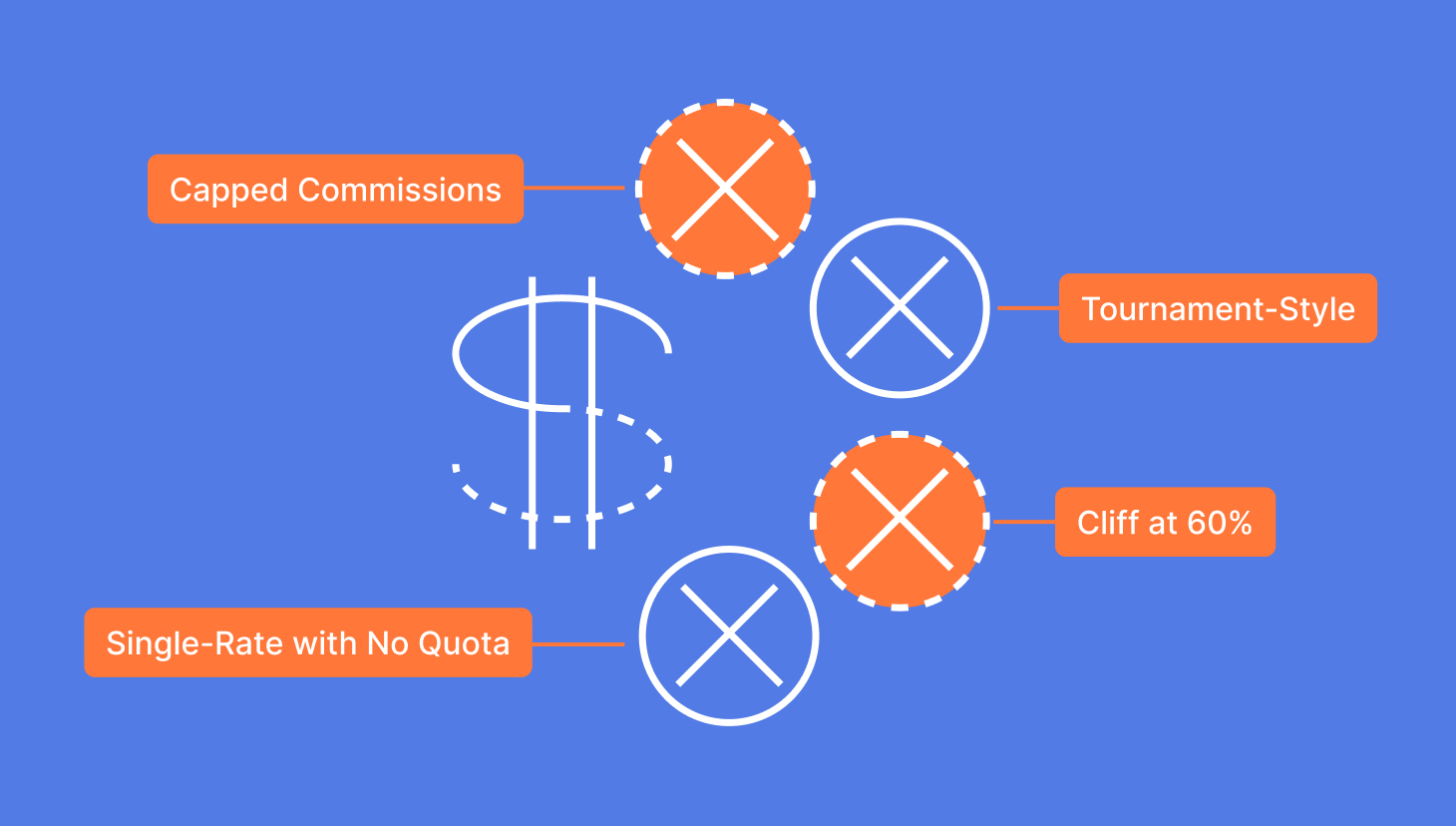What Is Sales Productivity?
Sales productivity is the ratio of a sales team’s output to input. For instance, a ratio of revenue or closed deals to time, effort, and resources used. It measures how efficiently a sales team converts resources like time and effort into revenue, quantifying the revenue generated per unit of resources used.
It’s a critical metric for organizational success as it directly impacts the bottom line by revealing how well the sales team utilizes their time and resources to generate revenue. This allows companies to identify areas for improvement and optimize their sales strategies to maximize profitability.
Improving sales productivity directly affects revenue by increasing the number of closed sales per salesperson, leading to higher overall sales figures. This, in turn, grows profitability by maximizing the return on sales efforts, reducing wasted time, and allowing for more efficient resource allocation.
Boosting sales productivity also positively affects team morale by giving sales reps a sense of accomplishment, recognition for their hard work, and the ability to spend more time on sales activities rather than on administrative tasks.
Below, we discuss how to measure it, sales productivity tools, and more.
How To Measure Sales Productivity
First, let’s start with measuring sales productivity.
Measuring and tracking your progress as you strive to boost sales productivity. Consider the following metrics, tools, and challenges as you start.
KPIs to Track:
| Revenue per sales rep | Revenue per sales rep is a metric that measures how much revenue each sales representative generates over a set period. |
| Average deal size | The average monetary value of a closed sales deal within a specific period. |
| Conversion rates through the sales funnel | The percentage of prospects who advance through the stages of the sales funnel to complete a purchase or other desired outcome. |
| Time spent on selling vs. administrative tasks | The portion of a salesperson’s workday dedicated to directly interacting with potential customers compared to non-sales-related activities. |
Tools and Methods:
| QuotaPath | QuotaPath is a sales incentive compensation management and commission tracking platform that enables businesses to optimize their compensation plans. This solution allows companies to easily track and generate sales performance reporting, calculate accurate commission payouts, and motivate sales reps to close deals for their company. |
| HubSpot CRM | HubSpot is a contact relationship management (CRM), marketing, sales, and customer service software company. Their goal is to help companies maximize sales and grow better. |
| Salesforce | Salesforce is a cloud-based customer relationship management (CRM) platform that helps companies develop better customer relationships. The platform offers tools for sales, service, marketing, commerce, and IT teams. |
| Gong | Gong.io is a Revenue Intelligence platform that captures and analyzes customer interactions, generating actionable insights that help improve revenue organizations. Gong.io records and combines customer data, helping businesses boost their sales efficiency, finetune strategies, and hasten revenue growth. |
| Clari | Clari’s Revenue Platform boosts efficiency, predictability, and growth along the entire revenue process. It gives revenue teams complete visibility into their business, maintains strict adherence to procedures and identifies potential risks and opportunities within the pipeline, improves forecast accuracy, and drives overall efficiency. |
Challenges in Measurement
However, please note that leaders do experience some challenges when measuring this.
Common difficulties measuring sales productivity include data accuracy, technology integration, metric overload, lack of alignment on metrics, and attribution.
Inaccurate, outdated, or unconsolidated data from multiple disparate platforms can cause misleading or incorrect evaluation. Failure to align and focus on metrics due to overwhelm by the sheer number of metrics or competing priorities can limit meaningful insights. Determining the exact factors to attribute to sales involving marketing campaigns and sales efforts can also be challenging.
7 Ways To Boost Sales Productivity
To help, here are seven tactics to drive sales productivity.
Knowing which metrics, how to track them, and being aware of the potential challenges is only the beginning. Now, you need to learn how to increase sales productivity.
- Set clear and achievable sales goals: Clear and realistic goals provide the sales team with a focused direction and attainable targets. This boosts motivation and facilitates more effective planning and execution.
- Provide ongoing training and skill development for your sales team: Learning and development enhance sales rep productivity by ensuring team members continuously improve their techniques, stay updated with industry trends, and effectively adapt to changing market conditions.
- Leverage commission automation tools like QuotaPath: Visibility into forecasted earnings helps sellers prioritize what deals to spend time on as they can quickly identify which ones make themselves (and the organization) the most money.
- Streamline sales processes to minimize administrative tasks: Reducing non-sales tasks, including commission tracking, frees more time for sales reps to focus on core selling activities. Consequently, this enhances overall sales productivity and efficiency.
- Regularly analyze and optimize sales territory mapping for better coverage and efficiency: This leads to enhanced sales productivity and more strategic resource allocation.
- Use data-driven insights to prioritize high-potential leads and opportunities: These insights enable your sales team to focus their efforts where they are most likely to succeed, thereby maximizing efficiency and enhancing overall sales productivity.
- Foster collaboration between sales, marketing, and RevOps to ensure alignment and resource sharing: Collaboration across teams leads to a cohesive strategy to increase sales productivity and drive better business outcomes.
Why You Should Care About Improving Sales Productivity
Although improving sales productivity is continuous, the rewards are worth the effort. For instance, McKinsey found that the top productivity companies generate 2.5 times higher gross margins than the least productive, giving them higher revenue potential.
The same study showed that top companies had better resource utilization, offloaded or automated non-sales activities, increasing sales team capacity by 20 percent by doing more with less. So, it’s not surprising that the study also found that businesses with greater sales productivity had enhanced ROI, generating 2.6 times the sales ROI of laggards.
Another benefit of improving sales productivity is a significantly stronger competitive advantage, allowing an organization to generate more revenue with the same resources. They gain the ability to close deals faster and adapt quickly to market changes, effectively outperforming competitors who are less efficient in their sales processes.
Boosting sales rep productivity improves employee satisfaction, making salespeople feel more efficient, accomplished, and valued. A survey revealed that employees are happier and more engaged when their work is meaningful and positively impacts the company. Plus, Forrester found that removing process friction and automating administrative tasks improves sales productivity while reducing seller stress and employee satisfaction.
Better customer experience is a natural outcome of improved sales productivity as it allows sales representatives to be more efficient, provide more personalized attention, and dedicate more time to understanding customer needs. This results in smoother and more satisfying interactions.
Lastly, improving sales productivity directly contributes to better scalability in a business, allowing a sales team to handle a larger volume of customers with the same resources. This means the sales process can be expanded without increasing overhead costs.
Common Challenges That Lower The Productivity Of Sales Teams
Remember, the common challenges that teams face that can hurt sales productivity include:
Inefficient sales processes: Wastes sales rep time on unnecessary tasks, repetitive actions, and redundant information gathering. This limits time spent actively engaging with potential customers and closing deals, resulting in lower sales numbers and missed opportunities.
Lack of clear goals or direction: This leaves salespeople unsure of what they should focus on, leading to wasted time, inconsistent effort, difficulty measuring success, and hindering reps’ ability to close deals effectively.
Excessive administrative tasks: Reduces selling time by engaging with potential customers, making sales calls, building relationships, and closing deals.
Poor lead quality or lack of prioritization: Receiving low-quality leads from marketing or an inability to identify high-potential prospects leads causes reps to waste valuable sales time chasing the wrong deals.
Inadequate training and onboarding: Leaves sales reps unprepared to engage with customers, significantly hindering performance effectively.
Misalignment between sales and other teams: When sales, marketing, and RevOps teams aren’t aligned on messaging and lead generation, this creates confusion.
Outdated or insufficient tools and technology: Too many disparate sales tools or poor integration between systems can create inefficiencies and data silos.
Difficulty tracking and analyzing performance data: Makes it more difficult to identify areas for improvement and make informed decisions to drive sales growth.
Low employee morale or high turnover: This creates a disengaged workforce, decreased motivation, poorer customer service, increased errors, and a disruption in workflow as new employees are onboarded. This ultimately results in fewer closed sales and lower overall revenue.
Unrealistic quotas or poorly designed compensation plans: Demotivates salespeople, leading to decreased effort and less focus on quality sales practice. This often results in higher turnover, as reps feel unable to achieve their targets and earn a fair reward for their work, thus impacting overall sales performance.
Ineffective communication and collaboration: Leads to misunderstandings and lost opportunities.
Market competition and external economic pressures: This can lead to price wars, longer sales cycles, and increased stress on sales teams as they struggle to meet targets amid tough economic conditions.
Design, track, and manage variable incentives with QuotaPath. Give your RevOps, finance, and sales teams transparency into sales compensation.
Talk to SalesStart Boosting Sales Productivity with QuotaPath
Sales productivity is the ratio of a sales team’s output to its input. It measures how efficiently the team converts resources into revenue and is a critical metric.
Improving sales rep productivity enhances revenue by increasing closed sales per salesperson, maximizing profitability, and allowing for efficient resource allocation while boosting team morale.
Leverage the insights and tips we’ve shared to increase sales productivity in your organization and reap the rewards.
See how QuotaPath helps you boost sales productivity. Schedule time with a team member today.



